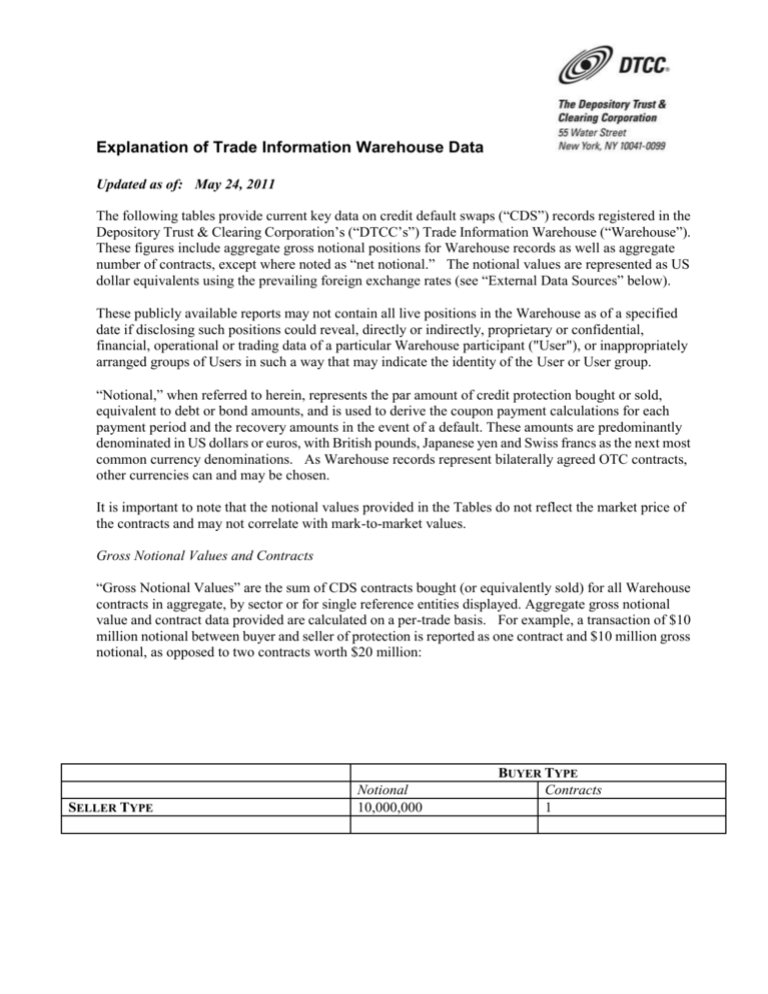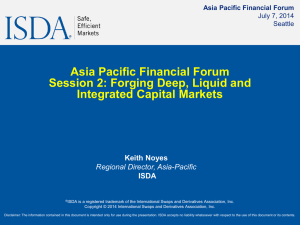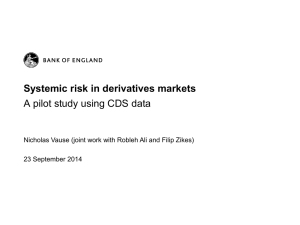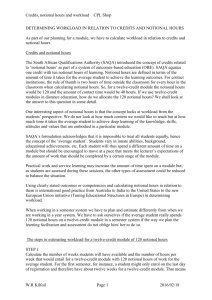Explanation of Trade Information Warehouse Data
advertisement

Explanation of Trade Information Warehouse Data Updated as of: May 24, 2011 The following tables provide current key data on credit default swaps (“CDS”) records registered in the Depository Trust & Clearing Corporation‟s (“DTCC‟s”) Trade Information Warehouse (“Warehouse”). These figures include aggregate gross notional positions for Warehouse records as well as aggregate number of contracts, except where noted as “net notional.” The notional values are represented as US dollar equivalents using the prevailing foreign exchange rates (see “External Data Sources” below). These publicly available reports may not contain all live positions in the Warehouse as of a specified date if disclosing such positions could reveal, directly or indirectly, proprietary or confidential, financial, operational or trading data of a particular Warehouse participant ("User"), or inappropriately arranged groups of Users in such a way that may indicate the identity of the User or User group. “Notional,” when referred to herein, represents the par amount of credit protection bought or sold, equivalent to debt or bond amounts, and is used to derive the coupon payment calculations for each payment period and the recovery amounts in the event of a default. These amounts are predominantly denominated in US dollars or euros, with British pounds, Japanese yen and Swiss francs as the next most common currency denominations. As Warehouse records represent bilaterally agreed OTC contracts, other currencies can and may be chosen. It is important to note that the notional values provided in the Tables do not reflect the market price of the contracts and may not correlate with mark-to-market values. Gross Notional Values and Contracts “Gross Notional Values” are the sum of CDS contracts bought (or equivalently sold) for all Warehouse contracts in aggregate, by sector or for single reference entities displayed. Aggregate gross notional value and contract data provided are calculated on a per-trade basis. For example, a transaction of $10 million notional between buyer and seller of protection is reported as one contract and $10 million gross notional, as opposed to two contracts worth $20 million: SELLER TYPE Notional 10,000,000 BUYER TYPE Contracts 1 Net Notional Values “Net Notional Values” with respect to any single reference entity is the sum of the net protection bought by net buyers (or equivalently net protection sold by net sellers). The aggregate net notional data provided is calculated based on counterparty family. A counterparty family will typically include all of the accounts of a particular asset manager or corporate affiliates rolled up to the holding company level. Aggregate net notional data reported is the sum of net protection bought (or equivalently sold) across all counterparty families. Net notional values are displayed only for single reference entities (single names and indices) and therefore only provided for tables 6, 7, 14 and 15. Net notional positions generally represent the maximum possible net funds transfers between net sellers of protection and net buyers of protection that could be required upon the occurrence of a credit event relating to particular reference entities. (Actual net funds transfers are dependent on the recovery rate for the underlying bonds or other debt instruments.) Example of Aggregate Net Notional Calculation * The highlighted yellow box is the only number displayed for the Net Notional Value Counterparty Family A Counterparty Family B Counterparty Family C Counterparty Family D Gross Notional Aggregate Net Notional Sold Aggregate Net Notional Bought Total Gross Notional of CDS Bought on Reference Entity X 135,000,000 200,000,000 100,000,000 30,000,000 465,000,000 Total Gross Notional of CDS Sold on Reference Entity X -150,000,000 -175,000,000 -90,000,000 -50,000,000 -465,000,000 Net Notional Positions on Reference Entity X -15,000,000 25,000,000 10,000,000 -20,000,000 0 -35,000,000 *35,000,000 Layout The data provided is divided into four sections. Section I (Tables 1 - 8) provides data on all live positions in the Warehouse as of specified date. Section II (Tables 9 - 16) provides the change in gross notional, contracts outstanding and net notional in the Warehouse from the prior week. Section III (Tables 17 -23) provides information on all transaction activity, such as new trades, assignments, and terminations that were confirmed within the specified week reflecting either an increase or decrease in overall positions. Section IV (Weekly Transaction Activity) provides weekly activity where market participants were engaging in market risk transfer activity. The transaction types include new trades between two parties, a termination of an existing transaction, or the assignment of an existing transaction to a third party. Section IV excludes transactions which did not result in a change in the market risk position of the market participants, and are not market activity. For example, central counterparty clearing, and portfolio compression both terminate existing transactions and re-book new transactions or amend existing transactions. These transactions still maintain the same risk profile and consequently are not included as “market risk transfer activity” The Warehouse operates globally 24 hours a day, 6 days a week; it closes from Saturday afternoon to Sunday afternoon for routine system maintenance All tables will include those records with “Certain” status in the Warehouse. Certain status indicates positions where both counterparties have entered and confirmed an original transaction. These records may have been updated with a post-trade event, such as a termination or assignment. The amounts shown are the currently agreed upon positions. There are no “open” or “unconfirmed‟ events outstanding on these trades. With the exception of Section III, the tables do not include “Unconfirmed” or “Uncertain” records. “Unconfirmed” records are transactions that are in the process of being confirmed in DTCC Deriv/SERV‟s matching and confirmation system for the first time. Uncertain status represents records maintained in the Warehouse that were confirmed and Certain at one point in time but that currently have an outstanding unconfirmed post-trade event, such as an assignment or termination. Section III Tables will identify any “Uncertain” transactions that were “Certain” in the prior week and became “Uncertain” in the current week due to a post trade event (“PTE”) action. This population of trades will be classified under the heading “PTE In-Flight”. This section also includes transactions that were “Uncertain” in the prior week and became “Certain” in the current week due to PTE action being completed. The data for all the tables was extracted on the evening of the indicated “As of Date” referenced in the table headings. This data indicates real-time contract positions, which is subject to subsequent submissions and/or events. As a result, the data provided in the tables represent a point in time view. Key Definitions: Dealer: Defined as any user that is, or is an affiliate of a user who is, in the business of making markets or dealing in credit derivative products. Non Dealer/Customers: Defined as any user that is not a Dealer and that uses the system to confirm eligible credit derivative transactions, primarily with Dealers. These include institutions such as traditional asset management firms, hedge funds, insurance companies, etc. On-the-Run: Defined as the most recently published Series on an Index as provided by Markit. Off-the-Run: Defined as all prior Series on an Index as provided by Markit. DC Region: „Determinations Committee‟ Region - This column identifies the region associated with the predominant trading style associated with each reference entity name, based on the documentation type of the underlying trades. For example, transactions traded as StandardNorthAmericanCorporate would be associated with the Americas Region. Where more than 25% of the transactions are associated with a region, that region has been included; in some cases therefore this attribute shows two or more regions. The regions used are consistent with those for which there are Determinations Committees within the International Swaps and Derivatives Association, Inc. (ISDA). New Trades: This population represents newly traded contracts. Full Terminations: This population represents the unwinding of a “Certain” contract in the Warehouse. 100% of the Notional Value is terminated. Trade Compression: The industry engages in trade compression cycles on a periodic basis for single name reference entities and indices. The objective of a trade compression is to maintain the same risk profile but reduce the number of contracts and Gross Notional Value held by participants. Compression cycles involve both Full Terminations and New Trades. Full Assignments: This population represents existing contracts in the Warehouse where one party in the existing bilateral contract (“Transferor”) assigns their entire position, (100% of the Notional Value) to another party (“Transferee”). Note, since transaction is the transfer of a pre-existing Warehouse position to another party, it does not affect Gross Notional Value or Contract totals. Partial Terminations: Same definition as Full Terminations, except that only a portion of the Notional Value is terminated. Partial Assignments: Same definition as Full Assignments, except that the Transferor only assigns a portion of the Gross Notional Value to the Transferee. Backloads: The Warehouse allows participants to register contracts previously executed and confirmed non-electronically. These transactions impact both Gross Notional Value and Contract totals, but are not indicative of new trade activity. Exits: This population represents contracts that have been removed from the Warehouse bilaterally by participants. Exits are most commonly processed at the conclusion of a single name credit event, succession event, or upon other activity typically confirmed outside the Warehouse (e.g. bankruptcy close out procedures). Matured Transactions: This population represents contracts that have reached the end of the contract (referred to as the “Scheduled Termination Date”). PTE In-Flight: This population represents contracts that were “Certain” in the prior week and became “Uncertain” in the current week due to a Post Trade Event ‘PTE‟action, such as an Assignment or Termination. PTE Completed: This population represents contracts that were “Uncertain” in the prior week and now “Certain” due to a Post Trade Event having been completed, such as an Assignments or Terminations. External Data Sources: Foreign Exchange Rates: Interactive Data Corporation (www.interactivedata.com) Reference Entity Type, Market Sector, : Markit RED CDS data using “markitsector” value (www.markit.com)






